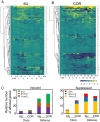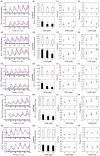Coronatine is more potent than jasmonates in regulating Arabidopsis circadian clock
- PMID: 32732994
- PMCID: PMC7393363
- DOI: 10.1038/s41598-020-69627-2
Coronatine is more potent than jasmonates in regulating Arabidopsis circadian clock
Abstract
Recent studies establish a crucial role of the circadian clock in regulating plant defense against pathogens. Whether pathogens modulate host circadian clock as a potential strategy to suppress host innate immunity is not well understood. Coronatine is a toxin produced by the bacterial pathogen Pseudomonas syringae that is known to counteract Arabidopsis defense through mimicking defense signaling molecules, jasmonates (JAs). We report here that COR preferentially suppresses expression of clock-related genes in high throughput gene expression studies, compared with the plant-derived JA molecule methyl jasmonate (MJ). COR treatment dampens the amplitude and lengthens the period of all four reporters tested while MJ and another JA agonist JA-isoleucine (JA-Ile) only affect some reporters. COR, MJ, and JA-Ile act through the canonical JA receptor COI1 in clock regulation. These data support a stronger role of the pathogen-derived molecule COR than plant-derived JA molecules in regulating Arabidopsis clock. Further study shall reveal mechanisms underlying COR regulation of host circadian clock.
Conflict of interest statement
The authors declare no competing interests.
Figures



Similar articles
-
COI1 is a critical component of a receptor for jasmonate and the bacterial virulence factor coronatine.Proc Natl Acad Sci U S A. 2008 May 13;105(19):7100-5. doi: 10.1073/pnas.0802332105. Epub 2008 May 5. Proc Natl Acad Sci U S A. 2008. PMID: 18458331 Free PMC article.
-
Two novel RING-type ubiquitin ligases, RGLG3 and RGLG4, are essential for jasmonate-mediated responses in Arabidopsis.Plant Physiol. 2012 Oct;160(2):808-22. doi: 10.1104/pp.112.203422. Epub 2012 Aug 16. Plant Physiol. 2012. PMID: 22898498 Free PMC article.
-
The coronatine toxin of Pseudomonas syringae is a multifunctional suppressor of Arabidopsis defense.Plant Cell. 2012 Nov;24(11):4763-74. doi: 10.1105/tpc.112.105312. Epub 2012 Nov 30. Plant Cell. 2012. PMID: 23204405 Free PMC article.
-
Circadian control of jasmonates and salicylates: the clock role in plant defense.Plant Signal Behav. 2013 Feb;8(2):e23123. doi: 10.4161/psb.23123. Epub 2013 Jan 8. Plant Signal Behav. 2013. PMID: 23299428 Free PMC article. Review.
-
The phytotoxin coronatine is a multifunctional component of the virulence armament of Pseudomonas syringae.Planta. 2014 Dec;240(6):1149-65. doi: 10.1007/s00425-014-2151-x. Epub 2014 Aug 26. Planta. 2014. PMID: 25156488 Free PMC article. Review.
Cited by
-
Application of coronarin enhances maize drought tolerance by affecting interactions between rhizosphere fungal community and metabolites.Comput Struct Biotechnol J. 2023 Oct 23;21:5273-5284. doi: 10.1016/j.csbj.2023.10.043. eCollection 2023. Comput Struct Biotechnol J. 2023. PMID: 37954150 Free PMC article.
References
Publication types
MeSH terms
Substances
LinkOut - more resources
Full Text Sources
Molecular Biology Databases

